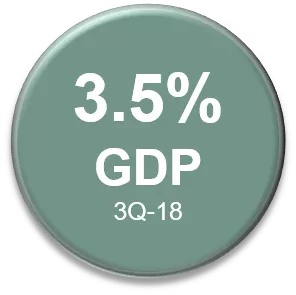Economic Commentary on November 2018 Employment Report
By John Beuerlein, chief economist, Pohlad Companies

Chief Economist
Pohlad Companies
Although market volatility has remained elevated since the beginning of 4Q-18, ongoing U.S. economic reports indicate that fundamentals remain steady. To be sure, however, trade tensions and various geo-political events are creating substantial uncertainty about the continued viability of global growth. The November jobs report, issued on Dec. 7, delivered a picture of solid job growth into year-end despite a weaker than expected headline payroll number. Nonfarm payrolls increased by 155,000 – expected to be 198,000. Average hourly earnings were also slightly weaker than expected, but wage growth has noticeably intensified over the last couple of months. October’s strong wage growth reading was suspect due to hurricane effects, but a second straight month of above 3% year-over-year age growth suggests the trend is improving and will likely continue to do so into 2019.

The unemployment rate held at the lowest level of 3.7% in almost five decades. The second reading of 3Q-18 GDP confirmed the initial reading of 3.5%. While economic momentum is expected to slow slightly in 4Q-18, it is still expected that real GDP growth for the calendar year will be 3% or better, making this the strongest calendar year of real GDP growth since 2005. The GDP report also provided a reading on 3Q-18 corporate profitability. Corporate profits rose by 3.4% in 3Q-18 compared to 2Q-18, the fastest rate since 2Q-14, and by 10.3% for the last four quarters. GDP growth in 2019 is expected to slow to 2.4% as the impact of fiscal stimulus over the past year wanes, and the impact of rising interest rates impacts interest sensitive sectors (e.g. autos and home sales).

Despite the reported strength of GDP in recent quarters, inflation remains muted. The current readings of key inflation indices confirm at least a temporary easing of inflationary pressures as the year draws to a close. Since the end of September, oil prices have fallen approximately $25/barrel (33%), and commodity prices in general are off by 10%. Softer inflation numbers combined with concerns about global economic growth have resulted in interest rates moving lower. The 10-year treasury yield has declined 50 b.p. this quarter and now stands at 2.85%. Whether or not the Fed slows the expected pace of interest rate increases in 2019 will be highly dependent on upcoming economic data. As of now, it is still expected that the Fed will raise the Fed Funds rate to 2.50% at their December 18 – 19 meeting. Chairman Powell has stated that rates are now just below the neutral level (neither stimulative nor restrictive). Additional statements by a number of Fed governors suggest that the pace of interest rate increases will likely slow in 2019. The market is now expecting only one more Fed Funds rate increase over the next two years after the December hike. Not to be forgotten, however, is the fact that the Fed continues to reduce its balance sheet by $50 billion/month – effectively tightening liquidity without ostensibly raising rates. The muted inflation outlook coupled with increasing global financial stresses suggests that the Fed will implement a cautious path of raising rates above what they consider to be the neutral level – 2.5% - 3.0%. Assuming that the employment landscape remains healthy in the US, it is inflation expectations that will be the driver of how aggressively the Fed raises interest rates in 2019.